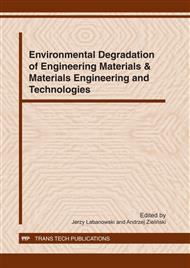p.179
p.185
p.193
p.201
p.207
p.215
p.225
p.233
p.241
Evaluation of Hydrogen Degradation by In Situ Ultrasonic Testing
Abstract:
In this paper, the results are presented of the ultrasonic investigations of hydrogen degradation of 09G2S carbon steel. Samples of the steel were hydrogen charged with simultaneous registration of the ultrasonic signal. The results of ultrasonic investigations were verified by Light Microscopy (LM), Scanning Electron Microscopy (SEM) and X-ray microanalysis technique (EDS). It was shown that the in-situ ultrasonic flaw detection can be used to monitor the early stages of hydrogen degradation, i.e. the formation of microcracks caused by hydrogen trapping at nonmetallic inclusions and hydrogen blistering.
Info:
Periodical:
Pages:
207-214
Citation:
Online since:
December 2011
Keywords:
Price:
Сopyright:
© 2012 Trans Tech Publications Ltd. All Rights Reserved
Share:
Citation:


